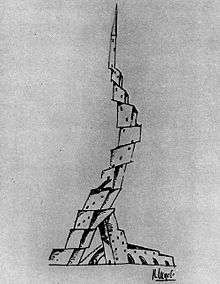Avant-garde architecture
Avant-garde architecture is architecture which is innovative and radical. There have been a variety of architects and movements whose work has been characterised in this way, especially Modernism. Other examples include Constructivism, Neoplasticism (De Stijl) and Expressionism.[1]

Concept
Avant-garde architecture has been described as progressive in terms of aesthetics. However, it is noted for covering a broad range of aesthetic and political spectrum. It is associated with the liberal left but also cited as apolitical, right-wing, and conservative in its politics and aesthetics.[2] It is also considered a stream within modernism that is anti-elitist and open to the contamination of mass culture.[3]
The concept draws from the idea of integration of life and art. In the De Stijl Manifesto V, it was stated that art and life are not separate domains, hence, the argument that art is not an illusion or disconnected from reality.[4] This view pushed for the construction of an environment that is according to the creative laws derived from a fixed principle.[4]
A conceptualization by Le Corbusier described avant-garde architecture as constructed for the pleasure of the eye and comes with "inner cleanness, for the course adopted leads to a refusal to allow anything at all which is not correct, authorised, intended, desired, thought-out."[5]
Criticism
Critics note that avant-garde architecture contradicts the very definition of architecture because its position is contrary to its most specific characteristics.[3] Its importance is said to be exaggerated since it is always marginal to any decisive change.[6] It is also noted that many avat-garde architectural projects do not fare well once evaluated according to suitability principles.[7] According to Eileen Gray, it is obsessed with the external at the expense of the interior.[5]
Architects
- Amaury Pluyaut
- Cedric Price
- Daniel Libeskind
- Frank Gehry
- Frei Otto
- Greg Lynn
- Oscar Niemeyer
- Peter Eisenman
- Rem Koolhaas
- Wolf D. Prix
- Zaha Hadid
- Walter Gropius
Schools and movements
- Archigram
- Bauhaus
- Brutalist architecture
- Constructivist architecture
- Metabolism (architecture)
- Neofuturism
- Neoplasticism
- Rationalism (architecture)
- Russian avant-garde architects and their work
- Situationist International
See also
References
- Heynen, Hilde (2004), "Avant Garde", Encyclopedia of Twentieth Century Architecture, Vol. 1, Taylor & Francis, pp. 97–99, ISBN 978-1579584337
- Berke, Deborah; Harris, Steven (2012). Architecture of the Everyday. New York: Princeton Architectural Press. p. 146. ISBN 1568981147.
- Baird, George (2003). The Space of Appearance. MIT Press. p. 354. ISBN 978-0-262-52343-1.
- Lahiji, Nadir (2019). An Architecture Manifesto: Critical Reason and Theories of a Failed Practice. Oxon: Routledge. ISBN 978-0-429-88506-8.
- Rault, Jasmine (2016). Eileen Gray and the Design of Sapphic Modernity: Staying In. Oxon: Routledge. p. 19. ISBN 9780754669616.
- Hays, K. Michael (1998). Oppositions Reader: Selected Essays 1973-1984. New York: Princeton Architectural Press. p. 391. ISBN 1-56898-152-X.
- Young, James O. (2003). Art and Knowledge. London: Routledge. p. 143. ISBN 0415256461.